From Print to Photograph, Stage to Page, and East to West: Transmedial Narratives and Cross-Cultural Understanding in Ogawa Kazumasa’s Scenes from the Chiushingura and the Story of the Forty-Seven Rōnin
by Karen M. FraserKaren M. Fraser is associate professor of art history and museum studies at the University of San Francisco. She earned her PhD in Japanese art history from Stanford University, where she studied both traditional Japanese art and the history of photography. Her research focuses on modern Japanese visual culture, with particular interests in Japanese photography from ca. 1860 through the 1930s; cross-cultural interactions and influences between Japan and the West; gender in modern Japanese art and photography; and museum and exhibition history. Her research has been supported by grants from the Japan Foundation and the Sainsbury Institute for the Study of Japanese Arts and Cultures, among others. Her publications have appeared in a number of journals and edited volumes, including History of Photography and the Review of Japanese Culture and Society, and she is the author of the monograph Photography and Japan (Reaktion, 2011).
Email the author: kfraser2[at]usfca.edu
Citation: Karen M. Fraser, “From Print to Photograph, Stage to Page, and East to West: Transmedial Narratives and Cross-Cultural Understanding in Ogawa Kazumasa’s Scenes from the Chiushingura and the Story of the Forty-Seven Rōnin,” Nineteenth-Century Art Worldwide 22, no. 2 (Autumn 2023), https://doi.org/10.29411/ncaw.2023.22.2.2.
This work is licensed under a Creative Commons Attribution-NonCommercial 4.0 International License  unless otherwise noted.
unless otherwise noted.
Your browser will either open the file, download it to a folder, or display a dialog with options.
From the early 1890s through the 1910s, the Japanese photographer Ogawa Kazumasa (1860–1929) published an estimated three hundred photographically illustrated books via his printing company, the Ogawa Shashin Seihanjō. Many of these were aimed at English-speaking audiences, with topics ranging from Japanese beauties to scenic locations such as Nikkō to visual surveys of historical Japanese dress. Ogawa advertised in popular English-language travel guides of the late nineteenth century and his name was well known to Westerners in Japan.[1] Judging by the number of books issued by Ogawa that can still be found in North American and European libraries and museum collections, these volumes circulated widely at the time, indicating that they played a significant role in educating Westerners about Japanese culture.
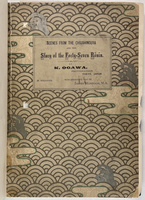
One volume published in 1892, Scenes from the Chiushingura [sic] and the Story of the Forty-Seven Rōnin, is particularly distinctive, containing several elements that are unusual in the context of Ogawa’s larger publishing output of the early 1890s.[2] First, the book includes extensive text written by the Scottish author James Murdoch (1856–1921), with fifty-two numbered text pages. Approximately half of these present a narrative overview of the complex historical incident to which the title refers, while the remainder are explanations of the seventeen photographic plates and the historically based play they illustrate. Despite this extensive written narrative, Ogawa’s name is highlighted prominently on the cover, marked by a large and elaborate font, while Murdoch is noted in a smaller, plain font, clearly suggesting that Murdoch’s authorship is secondary in importance (fig. 1). The title’s emphasis on “Scenes from” the story further denotes the significance of Ogawa’s contribution: the photographic images.
Secondly, the book’s images illustrate a specific historical narrative, one very well known in Japan, that formed the basis for one of the country’s most popular Edo-period (1615–1868) kabuki plays. Ogawa’s other books of the 1890s tended to depict more general aspects of Japanese culture already well established in the genre of “Yokohama photography” aimed at Western tourists, such as local customs or scenic views. They did not typically “tell stories” in this manner, let alone attempt to visualize such a complex and legendary tale as Chūshingura.[3] Moreover, it was highly unusual in nineteenth-century Japanese visual culture to have a set of photographs correspond so directly to a specific literary, theatrical, or historical work. Thus, this volume is quite exceptional, offering a compelling opportunity to consider the relationship between text and image in translating an unfamiliar narrative across cultures. As a kabuki play, the story also had a lengthy history of illustration in woodblock prints. Accordingly, the core set of images in this volume provides a unique opportunity to compare these photographic depictions with their woodblock-print precedents. How did photography translate these earlier images, and what can this publication tell us about photography’s role in Meiji-era (1868–1912) Japanese and transcultural media? How might the volume have been perceived by contemporary English-speaking viewers, and how can it help us understand late nineteenth-century visuality and cross-cultural exchanges more broadly?
This article attempts to shed light on these questions by analyzing the photographs, comparing their compositions to woodblock prints with the same subject matter, and considering how the intended Western audience likely perceived the story presented in this volume via the interplay between photographic images and written text. In addition to visual and contextual historical analysis, I draw on several core concepts from the field of narrative theory to help envision what kind of narrative understanding of this work was facilitated by the choices of visual and written media. “Intermediality” and “transmediality” are two interrelated, key concepts that can help with this understanding. While there is considerable debate within the field of literary studies about the exact definitions and usages of these terms, “intermediality” in its most general sense concerns the relationship between literature and visual media in conveying narrative, and, further, can apply to “any transgression of boundaries between media.”[4] “Transmediality” refers to phenomena or motifs that appear across a variety of different media and are not confined to one single narrative medium; it relates to how a narrative evolves as it traverses media.[5] The more obvious media of woodblock print, photography, and written text are the primary focus of this article, but beyond these we can also consider several additional types of media used in crafting the Chūshingura narrative presented in Ogawa’s volume: the theater itself, both fictional and nonfictional writing, and even oral storytelling. All of these ultimately converge in this work to help frame its transmission across cultures.
There is an extensive body of scholarship in both Japanese and English on Chūshingura. Within the fields of literature and history, the existing research has almost completely focused on its significance within Japanese cultural, theatrical, political, and historical contexts.[6] Numerous exhibitions and museum catalogues have featured popular prints of the tale, and art historical research has examined woodblock prints of the play as part of the vast body of broader scholarship on ukiyo-e and its relationship to the theater.[7] However, there have been no studies that look at photographs of the play, and very little research on the relationship of photography to the theater in Japan in general, a subject with rich potential for investigation given the long history of prints of the kabuki theater predating the advent of photography.[8] There has also been almost no scholarly attention given to Chūshingura in a broader global context. This article attempts to help rectify these oversights by offering a careful analysis of Scenes from the Chiushingura and the Story of the Forty-Seven Rōnin and considering how it may help us understand the many intersecting threads linking history, literature, theater, and modern visual media in the context of late nineteenth-century cross-cultural exchange.
Chelsea Foxwell’s article of 2004 surveying Chūshingura prints provides a useful overview of the different types of imagery used to imagine both the play and the historical narrative. Foxwell has argued that Japanese audiences of the Edo period understood woodblock-print illustrations of the play simultaneously as both fictional and historical images. She argues that the play had a “dual identity as a stage tradition and as the commemoration of an actual event.”[9] In her estimation, woodblock prints were particularly “capable of unifying the two realms by means of a single visualization that allowed for a double reading as history and as stage performance,” or “creative doubling.”[10] In a later essay she states that “far from being a simple reflection of the kabuki stage, Chūshingura prints functioned in several ways: they heightened the appreciation of the acting, reinforced the canonicity of certain poses and scenes, enhanced interpretations of the overall structure of dramatic irony in the play, and finally, they served as reminders and memorials of the historical event by encouraging the double reading of Chūshingura as theater and history.”[11] This capacity for a double reading, I argue, also pertains to Ogawa’s English-language, photographically illustrated version of Chiushingura.
While this distinctive volume is completely rooted in the complexities of Japanese visual and cultural traditions, the addition of the photographic medium to the long history of Chūshingura imagery, along with the amplification of the story for a Western audience, further complicate the dual understanding of this work as both fiction and history. Embedded in the widespread late nineteenth-century idea that the camera held a unique ability to capture information in a neutral, objective, and truthful fashion, photographic images were broadly understood to convey a sense of the “authentic” Japan to Western viewers, although we know today that that image was in fact highly constructed.[12] As I shall argue below, the use of photographic reproductions in this volume functioned on one level to reinforce the perception that the book presented an authentic historical narrative, which itself emerged from an important, recently published revisionist history within Japan. However, this factual and corrective narrative was not the only message connoted by the work; at the same time, the photographs and accompanying text also conveyed more theatrical and fantastical aspects of both the play and the historical events. Ultimately, I argue that Ogawa’s volume found a parallel level of understanding and appreciation as a work of both history and fiction in the English-speaking West, resonating with the way Japanese audiences understood woodblock prints of the play as articulated by Foxwell.
The article begins with a short overview of the Chūshingura story, followed by a brief introduction to Ogawa and his oeuvre. I then turn to look at the photographs, tracing their connections to the play and offering a comparative analysis of how they relate to their woodblock-print precedents. Finally, the article concludes by examining the interplay between Ogawa’s images and Murdoch’s text to help unpack the overarching narrative, contextualizing the volume and exploring how it was likely understood by its intended Anglo-American audience.
The Story and Its Literary and Theatrical History
Known by various titles including the Akō Incident, the Forty-Seven Rōnin, the Loyal League, and the most common literary reference, Chūshingura (The Treasury of Loyal Retainers), the story is complex and dramatic. Based on actual events, the historical Akō incident began early in 1701 at the court of the Tokugawa shogun. Asano Naganori, the lord of Akō domain, attacked and lightly wounded Kira Yoshinaka, the shogun’s court official, as Kira had been treating Asano contemptuously. As drawing a sword in the court was prohibited, Asano was ordered to commit seppuku (ritual suicide, also known as hara-kiri) and see his domain dissolved and his retainers become samurai without masters, or rōnin. Twenty-two months later (in the twelfth month of 1702), forty-seven of Asano’s retainers carried out a night attack on Kira’s mansion; Kira was killed and beheaded, and his severed head was taken as an offering to Asano’s grave at Sengakuji, a Buddhist temple. The rōnin then turned themselves in and awaited their fate. All forty-seven were sentenced to die by seppuku, which they committed on the fourth day of the second month in 1703.[13]
Embodying dual characteristics of the samurai ethos—loyalty and revenge—that were revered in the popular culture of the Edo period, these historical events were very quickly featured in literary and theatrical forms.[14] By the mid-eighteenth century, the story had become a popular and commonly staged kabuki play, with most productions derived from a script of 1748 titled Kanadehon Chūshingura (The Treasury of Loyal Retainers) by Takeda Izumo, Miyoshi Shōraku, and Namiki Senryū, which is also the basis for Ogawa’s illustrations and Murdoch’s text. Though rooted in historical facts, the play had to satisfy prohibitions against directly criticizing the shogunate by disguising both its characters and its plot, which it did by staging the drama in a different historical time and place, altering characters’ names (though sometimes these provide only a very thin disguise), and including a number of plot elements with no factual basis.[15] The resulting popular play offered viewers “pitched battles, love scenes, ceremonial gatherings of lords, a highway murder, delicate dances, and half a dozen intricate plots and intrigues.”[16] How could all this be translated effectively into a set of seventeen photographs, and how would an English-speaking audience have perceived the images depicting this complex and sometimes fantastical story?
The samurai values valorized in the play and in Japanese popular culture more broadly were also highly intriguing to Westerners fascinated by the recently opened Japan in the last decades of the nineteenth century. The Chūshingura story readily captured the Western imagination, and Ogawa’s volume was not the first version to circulate beyond Japan. In 1822, the earliest known account of the Akō incident in the West was mentioned in Isaac Titsingh’s posthumously published Illustrations of Japan.[17] By the 1870s, following the Meiji Restoration of 1868 and the official “opening” of Japan, there were multiple additional English-language versions based on the Kanadehon Chūshingura, including “The Forty-Seven Rōnins” in A. B. Mitford’s Tales of Old Japan, published in 1871, and Frederick V. Dickins’s version, Chiushingura, or, the Loyal League: A Japanese Romance, first published in 1875, with several later editions. The story was also adapted into an English-language play in 1915 by John Masefield, known as The Faithful. Dickins’s text is of greatest interest here as a point of visual comparison among English-language versions of the story: the 1880 edition includes a total of twenty-nine tricolored woodcut illustrations, while the 1892 version includes ten full color woodcuts (the artists of both sets of illustrations are not identified). Each of these sets of images corresponds fairly closely to woodblock prints of the play that had by then been circulating in Japan for decades. As I shall discuss below, these standardized compositions factored into Ogawa’s depictions as well.
Ogawa as Publisher and Photographer
One of Japan’s most successful early photographers, Ogawa was hitting his full professional stride in the early 1890s. Like the authors Mitford, Dickins, and Murdoch, Ogawa was a key figure in late nineteenth-century cultural exchanges taking place between Japan and the West. After developing an interest in photography and opening his first studio in 1877 at age seventeen, Ogawa traveled to the United States in 1882 to learn the latest printing and photomechanical reproduction technologies.[18] He studied in Philadelphia and Boston for approximately fifteen months, returning to Japan early in 1884. By 1889 Ogawa had established a photoengraving company specializing in collotypes, the Ogawa Shashin Seihanjō, with the financial support of a wealthy benefactor, Kajima Seibei. In 1889 Ogawa’s press started publishing Kokka (National essence), a long-running art journal featuring high-quality images that is still in existence today, and for which he produced photomechanical reproductions as well. In addition to publishing photographically illustrated books, Ogawa accrued a number of other noteworthy honors, including having his photographs on display at the 1893 Chicago World’s Fair and being named a fellow of the British Royal Society of Photography in 1895, the first Japanese photographer to gain that honor. Ogawa’s reputation was well deserved, as his work typically exhibits a very high level of technical excellence as well as a sophisticated overall artistic sensibility.
Chiushingura, like Ogawa’s other publications of this period, features a high-quality set of collotypes. One of the hallmarks of the collotype is that it produces a very fine-grained image. When viewed under a magnifying glass, the image looks much like a photograph itself and has the capability of showing a broad range of tones, while more rudimentary forms of mechanical reproduction would normally show the moiré or dot pattern of the mechanical printing process and have less subtle tonal variations. Collotype printing was an expensive and labor-intensive process which yielded a limited number of impressions of any single image.[19] By all accounts, Ogawa was particularly skilled at the technique.
A survey of contemporaneous English-language periodicals yields numerous positive reviews of Ogawa’s work. An 1889 article on the Photographic Society of Japan in Anthony’s Photographic Bulletin notes that “Mr. K. Ogawa showed some remarkably fine collotype prints.”[20] An article specifically on Ogawa the following year in the same publication comments: “These are certainly as fine as—I sometimes think finer than—anything done by collotype that I have ever seen.”[21] And another issue of Anthony’s Photographic Bulletin in 1893 compares Japanese photographs to those of the London Camera Club that were currently on view in Tokyo and finds the British work stronger on the whole, although it notes that, in terms of colorized photographs, “Mr. Ogawa’s snow scenes, however—chromo-collotypes—stand pre-eminent.”[22]
In addition to more general commentaries such as these, contemporary publications also sometimes included short reviews of specific books published by Ogawa. The Japan Weekly Mail wrote about his Costumes and Customs in 1892: “Mr. Ogawa has the field to himself in the matter of collotypes, as no other Japanese artist appears to approach him”; and again the following year: “Mr. Ogawa has published three more of his now justly celebrated albums. . . . As usual, the collotypes are of the highest order and the albums are beautifully got up. The third Album not published is the ‘Lilies of Japan.’ We have here twelve really exquisite collotype representations of the beautiful flowers for which Japan is famous.”[23] Yet another intriguing example discussing an album of photographs of the Great Earthquake of 1891 provides details on the overall quality of the publication:
The work which we were promised by Professors Milne and Burton on the terrible earth quake of last October, is now in the hands of the public. It is a noble volume, printed in luxurious type, on paper of the finest quality, and illustrated by no less than twenty-nine large plates. We doubt whether any volume of such a sumptuous character was ever before compiled and printed within so brief a period of the event it describes. Two months sufficed to collect materials for, illustrate, put into type, and bind a book that might reasonably have been the product of three or four times that interval . . . the book has been issued at the remarkably cheap price of six yen to subscribers, and seven and a half yen to the general public. How any margin of profit is left by such figures, we find difficulty in conceiving. The twenty-nine photographs, if purchased separately, would not be dear at five yen; the binding, which is handsome and solid, must have cost about a yen. What then remains for the printing and paper, to say nothing of the booksellers’ commission or of remuneration to the authors?[24]
While I have not found any commentary specifically on Chiushingura itself, this sampling of reviews confirms that Ogawa’s work was familiar to and critically esteemed by English-speaking contemporaries active in Japan and in the photographic world.
Visualizing the Story: Ogawa’s Illustrations
As a brief overview of the photographic series is fundamental to this analysis, the following section provides a basic synopsis of the play as viewed through the photographs. I note at the outset that little is known about the actual production of the images, and there is no known written documentation of Ogawa’s inspiration or his sources for this set of photographs. On the first page of Chiushingura, in the only text on this page, Ogawa gives his benefactor, Kajima, credit for assisting with the production of two-thirds of the plates in the book: “I have to thank Mr. Kajima Seibei for his kind assistance in taking the photographs of Plates V to XI.”[25] Unfortunately, as is often the case with nineteenth-century Japanese photographs, there is no clear indication of what role each man may have played in the production of the photos; Okatsuka Akiko notes that Kajima may have helped to prepare the staging of images and facilitated connections with the actors appearing in the photographs.[26] Regardless of the circumstances of production, Ogawa’s images employ an intriguing blend of realism and theatricality, utilizing actual places, stage sets, and the photography studio to create a compelling visual story. The resulting images effectively convey the key points of the narrative to his Western audience.
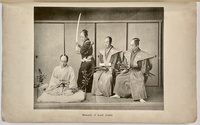
The first five plates help to set the scene, literally. The first photograph bears the title Harakiri of Lord Asano and is the only unnumbered plate (see fig. 2). The setting appears to be a standard Japanese interior situated within a photography studio, with a slightly raised platform of tatami mats and a set of sliding-door panels creating a tightly foregrounded scene. Arranged close to the front of the picture plane are four figures: Lord Asano (called Lord Enya Hangan in the play) sits on his knees at the left and appears to be on the verge of drawing his dagger across his abdomen. A shogunal representative stands close by with a sword, ready to complete the final stage of the ritual suicide once Asano has begun his task. Two additional samurai figures, also shogunal censors, witness the scene. This depiction corresponds to act 4 in the play, but its location at the very beginning of this volume, following page two, reinforces the overall novelty of hara-kiri, or ritual suicide by self-disembowelment, to a Western audience (note that the rest of the images appear quite a bit later after the corrective text discussed below, with plate 1 following page 28). With its tight composition highlighting this dramatic yet easily understood action, captured on the cusp of the moment of violence, this initial placement thus effectively fosters a compelling invitation into the tale. The image is also lacking any of the obvious theatrical or artificial elements that appear in most of the other photographs, allowing a viewer to suspend disbelief and imagine they are truly looking at Lord Asano in this moment.
The next four scene-setting photographs, plates 1–4 (figs. 3–6), collectively function to bring the viewer into the physical space of the events narrated and are not typically part of the most common standard print illustrations of the story. Plate 1, SengakuJi – The Well in Which the Head Was Washed (fig. 3), and plate 2, SengakuJi – Oishi’s Tomb (fig. 4), depict the Sengakuji temple, where the villain Kira’s head was presented at the tomb of the deceased Lord Akō once the vendetta was complete and where all of the rōnin were buried after they had committed seppuku. Plate 3, Kamakura (fig. 5), and plate 4, Daibutsu (fig. 6) introduce the viewer to the location where the events take place, with the city of Kamakura standing in for the city of Edo (modern Tokyo) in the play. The view of Kamakura in figure 5 is taken from an elevated, hilltop vantage point that foregrounds rows of scruffy trees that dwarf the town below. The text describes Kamakura in rather unflattering language, further discussed below, suggesting that the photograph may have been designed to reinforce that narrative. The Daibutsu in figure 6, a large, bronze Buddha figure located in Kamakura, is one of the most famous tourist destinations in the environs of greater Tokyo, and depictions of the sculpture figured frequently in the scenic visual narratives found in photographic tourist albums. This image is largely indistinguishable from many others of the same site circulating among Western viewers at the time.[27] Stylistically, figures 3–5 seem at odds with the other plates, illustrating a documentary style that, arguably, helps in crafting a sense of realism.
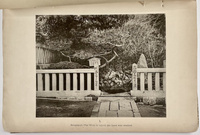
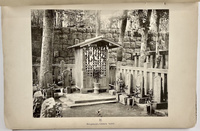
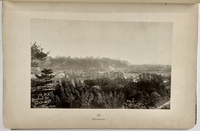
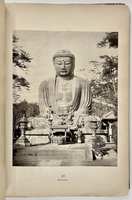
Plates 5–15 (figs. 7–10, 12–18) correspond with well-known scenes from the eleven acts of the play itself, unfolding in chronological order. The scene illustrated in plate 5, Lady Enya Recognizes Nitta’s Helmet (fig. 7), occurs in act 1 during a celebration at the Hachiman shrine, where the shogun’s brother announces that the helmet of Nitta Yoshisada, recently killed in battle by the shogun himself, will be installed in the shrine. Lady Enya, the wife of Enya Hangan (Lord Asano in real life) is asked to identify it. While she does so, the villain Moronō (Kira in the real story) tries to slip her a love letter, which she manages to surreptitiously decline. In the photographic view, Moronō/Kira is in the upper right. The setting here is far more theatrical than in the image of Lord Asano’s hara-kiri, clearly including multiple elements that seem to be drawn from a stage set: a two-dimensional representation of stairs frames the platform on which the shogun’s brother and Moronō sit, with a second, painted backdrop behind them and a third rather awkward view in the scenes of trees to either side.
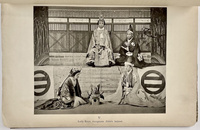
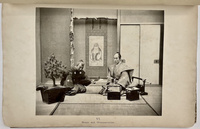
The scene illustrated in plate 6, Honzo and Wakasanosuke (fig. 8), which occurs in act 2, reverts to a less overtly theatrical setting, with the two characters sitting on tatami mats before a tokonoma alcove housing a hanging scroll. In this scene, Wakasanosuke (to the right) discloses to his retainer Honzo that he intends to kill Moronō/Kira, as retaliation for Kira’s affront toward Lady Enya (in addition to his generally insufferable behavior). The scene illustrated in plate 7 (fig. 9) corresponds to act 3, and shows Lord Enya’s attack on Moronō/Kira. The realism of this setting arguably falls somewhere between that of the photographs illustrated in figures 7 and 8, with the two figures dramatically posed in conflict on a tatami floor in front of a painted backdrop that seems theatrical and yet is not as artificial in appearance as that in figure 7. Act 4 is not illustrated in sequence here but is represented by the first, unnumbered plate of Lord Asano’s hara-kiri described above (see fig. 2).
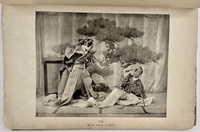
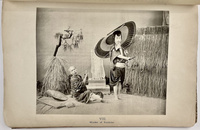
The scene illustrated in plate 8 (fig. 10) corresponds to act 5, in which Yoichibei, a minor character, is attacked and murdered by the villain Ono Sadakuro. The setting looks like a photo studio, with the camera framing the two characters at fairly close range and several props (the Buddhist statue, the pine tree, the fallen hat, and the parasol) indicating that the scene takes place outdoors. This act is not connected to the main story and is the first of several events in the play to have no historical correlation. Despite this, it was one of the most iconic compositions in woodblock prints of the play, with Ono framed by his parasol being one of the most readily recognizable illustrations (see fig. 11 for an example by Utagawa Kuniyasu). Also of note here is that the actor playing Yoichibei (at the left in the photograph) appears to be the same one playing Moronō/Kira in the photograph in the preceding plate.
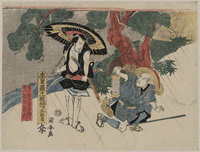
The scenes illustrated in plates 9 and 10 (figs. 12, 13) correspond to acts 6 and 7, respectively. These two scenes employ some common visual tropes found in other woodblock prints more generally (not necessarily just from the Chūshingura story), as they illustrate aspects of love stories that can be found in many kabuki and literary narratives. The Parting of Okaru and Kampei (fig. 12) shows a moving scene where Okaru leaves her husband Kampei, one of Enya’s retainers, to enter a brothel; she has been willingly sold to help finance Kampei’s role in the vendetta, an act confirming his loyalty to Enya/Asano. They are positioned with their backs to each other, facing different directions, and Okaru tugs at her handkerchief with her teeth—standardized poses and behavior that underscore the emotional intensity of their parting. This setting is one of the more interesting hybrid spaces in the series, combining a theatrically painted and very artificial-looking wall segment behind the two figures with seemingly functional sliding-door panels to the right.[28]
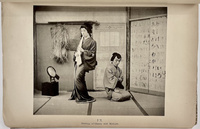
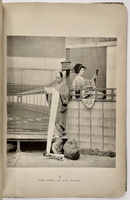
Okaru appears again in Plate 10 (see fig. 13), now residing in the brothel, where she tries to get a glimpse of a letter being read by the deceased Enya’s chief retainer Oishi, now the leader of the rōnin. Hiding underneath the veranda is another of Enya’s former retainers, now serving as a spy for the villain Moronō/Kira. Here again the setting is a very interesting, complex, hybrid space, with the area to the left clearly a painted backdrop but one that effectively gives a sense of depth and perspective to the building, while the veranda itself and Okaru’s perch both feel fully three-dimensional.
The scene illustrated in plate 11, Tonase and Konami on Their Way to Yamashina (fig. 14), which corresponds to act 8, represents a brief interlude in the story known as “The Bride’s Journey,” sometimes omitted from the play. The two characters are the wife and daughter of the retainer Honzo (seen in fig. 8), who set out on the road to Kyoto to reunite Tonase with her betrothed, Rikiya. Together with the image of the Daibutsu in figure 6, this scene is one that most resembles the more general imagery found in tourist photographs, which often included scenes of young women posing before a painted backdrop of Mount Fuji.[29]
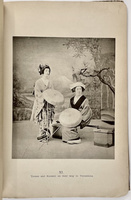
Tonase’s fiancé, Rikiya, appears in Plate 12 (fig. 15), corresponding to act 9. Rikiya is the son of Enya/Asano’s chief retainer. Here, Rikiya attacks Honzo, Tonase’s father, out of a mistaken belief that Honzo is disloyal. Honzo is willing to die in order to preserve his daughter Tonase’s future with Rikiya. As he dies, he leaves behind plans of Moronō/Kira’s house, where the night vendetta will take place, as a wedding gift to Rikiya and Tonase, thus confirming that he is in fact loyal to the rōnin. Again, the space depicted comes across as a hybrid of the real (snow on the ground and scattered on tree branches helps make the foreground look convincing) and the intentionally artificial (the flattened painted structure in the top right corner is clearly theatrical).
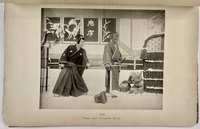
In the penultimate act 10, corresponding to the scene illustrated in plate 13, Ama-kawaya Gihei Put to the Test (fig. 16), the merchant Gihei has been tasked with keeping the rōnin’s weapons safe prior to the vendetta. Coming under attack, he defends the stash with his life, and is even willing to sacrifice his four-year-old son. This is another scene that is often omitted from theatrical versions of the story and for which there is no historical evidence. However, like the scene in Murder of Yoichibei (see fig. 10), it was frequently depicted and readily recognizable in print illustrations, with the standard composition showing Gihei seated atop the weapons cache, as he is here. Like select other interior scenes, this one has one of the more holistically believable settings, with only the small painted section directly behind Gihei appearing to be particularly artificial. The camera placement in this image appears identical to that in The Parting of Okaru and Kampei (see fig. 12), with the angles of the rear walls and the arrangement of the tatami mats lining up precisely.
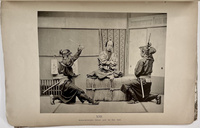
Scenes from act 11, the denouement, are shown in plates 14 and 15 (figs. 17, 18). When performed, this scene typically has little dialogue and a great deal of active fighting, making it particularly challenging to translate to a still visual medium. In The Discovery of Moronō (Kira) (fig. 17) several of the rōnin have found Moronō hiding in a coal shed. They offer him the opportunity to honorably commit seppuku but he tries to escape, so they end up beheading him. (They would later take the head to the well at Sengakuji [see fig. 3] to wash it and present it at the grave of their deceased Lord Enya.) The Rōnin outside the Ekōin (fig. 18) depicts the group on the way to their lord’s temple to kill themselves. Both of these scenes take place outdoors and incorporate a painted backdrop to help create that effect, but the backdrop in figure 18, with its repeated, undulating pattern implying a snowy landscape, is significantly more artificial looking than that in figure 17, which features a less stylized depiction of a simple wooden fence.
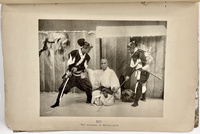
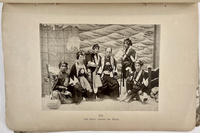
From Print to Photograph
Ogawa’s photographs are visually complex and immensely intriguing on their own, but they become even more compelling when compared with woodblock-print images of the play. As it turns out, one particular print series by the artist Katsushika Hokusai (1760–1849) makes for an especially apt comparison with Ogawa’s photographs. The twelve-sheet set was first published around 1801; a complete version featuring a limited color palette is available for viewing at the US Library of Congress website, while a slightly later print run, with more variety in color and some slight compositional adaptations, is available in the online Hokusai catalogue raisonné.[30] As the comparisons highlighted below illustrate, the compositions of Ogawa’s photographs track closely overall with those of Hokusai’s prints.
In some cases, the compositions are astonishingly similar. Ogawa’s Murder of Yoichibei positions the two central figures in nearly identical fashion to Hokusai’s print of the same scene (figs. 10, 19). In both scenes, Yoichibei is crouched at the left, his straw hat toppled onto the ground and his body straining away from the villain, Ono Sadakuro. Ono stands nearby with feet apart, drawing his sword, with the vegetal background of the photo echoing the more elaborate background of the print (though the iconic parasol lays folded on the ground in Hokusai’s image rather than being open). Ama-kawaya Gihei Put to the Test similarly makes use of the key body language highlighted in the prints (figs. 16, 20). In both scenes, Gihei sits atop the chest housing the weapons stash, his crossed legs awkwardly splayed, while the attacking figures assume similarly dramatic poses in each image. The squatting figure to the right in Hokusai’s print is almost literally mirrored by the figure at the left in Ogawa’s photograph. The background text in the photo also echoes some of that in the print, naming the Ama-kawaya House where the scene takes place.
Fig. 10, Ogawa Kazumasa, Murder of Yoichibei, 1892. Collotype book illustration. Published in Ogawa and Murdoch, Scenes from the Chiushingura and the Story of the Forty-Seven Rōnin (Tokyo: K. Ogawa, 1892), plate 8. Artwork in the public domain; image courtesy of the author.
Fig. 19, Katsushika Hokusai, Chūshingura, Godanme (Chūshingura, Act 5), 1801. Woodblock print. Library of Congress, Washington, DC. Artwork in the public domain; image courtesy of the Library of Congress.
Fig. 16, Ogawa Kazumasa, Ama-kawaya Gihei Put to the Test, 1892. Collotype book illustration. Published in Ogawa and Murdoch, Scenes from the Chiushingura and the Story of the Forty-Seven Rōnin (Tokyo: K. Ogawa, 1892), plate 13. Artwork in the public domain; image courtesy of the author.
Fig. 20, Katsushika Hokusai, Chūshingura, Jūdanme (Chūshingura, Act 10), 1801. Woodblock print. Library of Congress, Washington, DC. Artwork in the public domain; image courtesy of the Library of Congress.
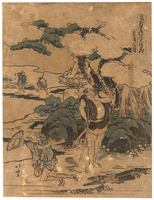
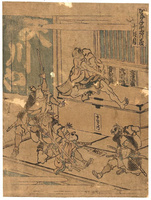
Several other scenes in Ogawa’s photographs closely mimic the body language of the central characters in Hokusai’s prints but vary more in their adaptation of the settings or environments. The figure of Okaru (figs. 12, 21) in Ogawa’s photograph adopts a nearly identical position to that of the same figure in the print, down to the flowing contour of her kimono, which falls open in a similar fashion. Kampei’s placement relative to Okaru is also virtually identical in the photograph and the print, but his crossed legs and sharply tilted head have been slightly altered. The straw cape and hat hanging on the wall in the photograph recall those in the print, but glimpses of the exterior landscape have disappeared in the latter. A similar level of compositional modification is visible in the images illustrated in figures 13 and 22. Ogawa’s photograph includes the veranda and balcony, the key elements of the scene, and shows the three main figures arranged in a close—yet not identical—approximation of the composition of the print. And still other of Ogawa’s images—those illustrating scenes from acts 1, 2, and 8 especially (see figs. 7, 8, 14)—retain key elements from the original print designs, readily conjuring up clear visual references. Remarkably, the key figures in the photographic scenes nearly always mimic the spatial relationships to one another as well as to the overall settings that appear in the prints, even when the photographic compositions stray from the print precedents.
Fig. 12, Ogawa Kazumasa, The Parting of Okaru and Kampei, 1892. Collotype book illustration. Published in Ogawa and Murdoch, Scenes from the Chiushingura and the Story of the Forty-Seven Rōnin (Tokyo: K. Ogawa, 1892), plate 9. Artwork in the public domain; image courtesy of the author.
Fig. 21, Katsushika Hokusai, Chūshingura, Rokudanme (Chūshingura, Act 6), 1801. Woodblock print. Library of Congress, Washington, DC. Artwork in the public domain; image courtesy of the Library of Congress.
Fig. 13, Ogawa Kazumasa, Oishi Reading the Secret Dispatch, 1892. Collotype book illustration. Published in Ogawa and Murdoch, Scenes from the Chiushingura and the Story of the Forty-Seven Rōnin (Tokyo: K. Ogawa, 1892), plate 10. Artwork in the public domain; image courtesy of the author.
Fig. 22, Katsushika Hokusai, Chūshingura, Shichidanme (Chūshingura, Act 7), 1801. Woodblock print. Library of Congress, Washington, DC. Artwork in the public domain; image courtesy of the Library of Congress.
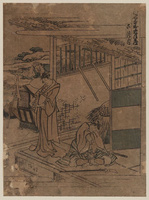
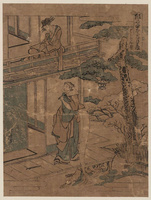
Interestingly, one scene where Ogawa did depart dramatically from Hokusai’s version is in act 4, the Harakiri of Lord Asano (see fig. 2). Hokusai’s print focuses on an earlier moment in the act where Lord Enya/Asano has been placed under house arrest and various household members discuss his fate. Instead of this bustling scene, Ogawa selected a moment of high drama, the ritual suicide with which the scene culminates, which allowed for much tighter focus on the figures. Seppuku images from this scene do occasionally appear in later prints of the play, so this compositional choice in and of itself is not so unusual. However, it is important here to remember the audience, as seppuku photographs form a small but significant subcategory of imagery that Western viewers found particularly intriguing, due to their fascination with this historical samurai custom.[31] Ogawa’s choice of this moment in the story would clearly have resonated in this context. Thus, by choosing this as the first image in the series, and placing it at a very early point in the volume as a whole rather than in the proper sequence of the acts of the play, he emphasized the “exoticness” of the action and effectively used it as a hook to draw in his audience.
From Stage to Page
In his book Chushingura and the Floating World, David Bell traces how woodblock prints relate to the theater experience. He writes as follows about kabuki and ukiyo-e: “Despite their apparently high degree of stylization to today’s eye, what both forms had in common was a degree of realism; they communicated by clear statement rather than through esoteric allusion, and every aspect of narrative or iconography was readily recognizable.”[32] Bell traces the evolution of images of the stage version of the Chūshingura story from their earliest incarnation in ukiyo-zoshi (illustrated books of popular literature from the Edo period) to single-sheet woodblock prints issued in a series. He notes that a key element of the earlier ukiyo-zoshi forms was that the images were heavily reliant on the text; the illustrations were not comprehensible without reading the accompanying narrative. As single-sheet print illustrations evolved, they reduced the text or omitted it entirely, resulting in the image alone bearing most or all of the meaning. According to Bell, “[w]hile a literary narrative could take its audience through every stage of the complicated Chushingura plot, the pictorial medium was necessarily selective. A single image could not portray all of the events, or the passage of time, for a whole act. Artists’ choices of the very particular aspect of each act that they should represent, while guided by pictorial interest or novelty, were still tempered by the need to maintain narrative continuity.”[33] Thus the composition needed to be selective in highlighting a limited set of motifs that would be readily legible, both in terms of each single print (so they could be sold individually) and the series as a whole.
Looking at Chūshingura prints by Hokusai, Bell argues that Hokusai chose scenes “that on the stage itself are relatively low in dialogue and which already rely on the communicative strength of visual spectacle rather than on verbal text. In choosing some less obvious scenes . . . he relies on his audience’s knowledge of other events in the play to make complete narrative sense.”[34] Bell suggests that by dramatizing the visual in this fashion, Hokusai satisfied the Edo market demand for novelty. Notably, the early nineteenth-century prints highlighted in the comparisons above were produced at precisely the moment in Hokusai’s evolution when he was developing the innovative print versions described by Bell.
Especially pertinent to my argument here is Bell’s reference to a photographic visuality inherent in Hokusai’s prints, first noted by Richard Lane:
While the play offered an apparently limitless range of choices, each graphic representation had to be recognizable and it had to operate alone, as a single “snapshot” image, without reference to events that occurred immediately before or after. . . . The scope and format of each is that which Richard Lane refers to as a ‘standard lens’ in photography. . . . In the majority [of the prints] the principal arrangement of the figures is in a clearly defined foreground zone, separated from the middle ground by a simple graphic device [and] . . . a flat, high-horizoned landscape. These three zones conform closely to the spatial construct of the kabuki stage: a gently sloping timber foreground area, sets, props, and flats directly behind and to either side, and a backdrop beyond this.[35]
Bell’s description of this spatial arrangement is equally applicable in describing the general arrangement of a photography studio, which would typically focus on the sitters—the main subject, equivalent to the actors in a play—in the foreground, posed in front of or surrounded by studio props in the middle ground, and incorporating a two-dimensional painted backdrop at the rear to suggest the illusion of distance. Photographic space and theatrical space thus overlap closely, leading organically to similarities in the compositional arrangements of studio-produced photographs and theatrically inspired prints.
Of particular note in all twelve of Ogawa’s main narrative photographs (see figs. 2, 7–10, 12–18) is how they embody this approach. The human figures are foregrounded within the physical space, posed in ways that clearly and quickly indicate the core dramatic and/or emotional aspect of the relevant scene. The specific narrative is readily apparent to viewers familiar with the play, but, arguably, even viewers unfamiliar with the story could extrapolate similar interpretations of the content from at least some of the images. As the comparisons highlighted above help to illustrate, the compositions of Ogawa’s photographs track closely overall with those of Hokusai’s prints. In each case, Ogawa created a similar focus on the key characters foregrounded in the prints, but reduced the number of figures to just two or three in most instances. Ogawa also utilized similar settings, simplifying and adapting them to the photographic medium primarily by eliminating the distant horizon and “flattening” the background. These reductions create a clear visual legibility in narrating the story.
To be very clear, I am not suggesting that Ogawa was necessarily looking directly to Hokusai as his model or that he deliberately intended to copy Hokusai’s compositions. Rather, by the time Scenes from the Chiushingura and the Story of the Forty-Seven Rōnin was published in 1892, the prints in Hokusai’s early nineteenth-century series had become perhaps the most common two-dimensional representations of the scenes. One can see by the printed illustrations included in the previous editions of the English-language version of the story by Dickins that similar compositions, based on these earlier woodblock-print conventions, were included there as well. Thus, Ogawa readily relied on these standardized visual modes to guide his photographic staging, an indication of the often-close links between photography and woodblock prints in photography’s first decades. Hokusai’s print series and Ogawa’s photographs both incorporate many of the same moments in the play that embody “the communicative strength of visual spectacle,” as articulated above by Bell. One transmedial concept holds that the “origin” of a given motif—in this case the poses and spatial constructs of the compositions—is relatively unimportant; what is significant is their interplay across various media, as seen here. However, the use of photography was not merely a duplication of earlier print precedents or dramatic poses fostered by the similarities between theatrical and photography-studio settings. As Marie-Laure Ryan notes, “a core of meaning may travel across media, but its narrative potential will be . . . actualized differently when it reaches a new medium.”[36] In this case, photographs added one significant new twist: translation of the print composition into the purportedly “realistic” medium of photography could, arguably, help to underscore the historically grounded “veracity” of the narrative told in the images.
From East to West: Murdoch’s Narrative and the Blending of Fact and Fiction
This attempt to underscore veracity is in fact reinforced by the written text itself in certain key sections. To reiterate, one of the notable aspects of the book is the fact that Ogawa—as photographer—is credited prominently in the title, with a clear suggestion that the photographs are the highlight of the volume. This may be somewhat surprising, given that the written text takes up fully three-quarters of the book. The book opens with approximately twenty-five pages of straight text, within which only a single plate appears, immediately following page two (the Harakiri of Lord Asano [see fig. 2]). In the second half of the book, the text is interspersed with the images: two or three pages of explanation are immediately followed by one or two full-page photographs depicting the scene(s) discussed. The author of the text, James Murdoch, arguably would have been significantly more familiar to a general, English-speaking audience than Ogawa was himself. Murdoch, a Scottish writer, had traveled to Japan as a foreign advisor in 1889. He taught history at the First Higher School in Tokyo from 1889 to 1893, and then left Japan briefly before returning for another two decades. Ogawa’s press had published Murdoch’s purely fictional story, Ayame-san, a Japanese Romance of the 23rd Year of Meiji (1890), earlier in 1892, which was accompanied by photographs taken by William K. Burton (rendered in collotype by Ogawa). Murdoch also wrote texts for several other photographically illustrated books published under Ogawa’s imprint. These included commentary for a variety of illustrated travel guides such as The Nikkō District (1893), The Hakone District (1892), and Sights and Scenes on the Tōkaidō (1893). Unlike all of these, Ogawa’s Chiushingura is a more complex blend of fact and fiction. Drawing on the intermedial and transmedial concepts introduced earlier, I now turn to consider how the text and images interact in this volume.
Murdoch’s text in Chiushingura seems to assume an audience with some fairly specific subject knowledge of Japanese culture. The first page, for instance, mentions a stipend of four thousand koku, a standard measure of rice, without defining koku.[37] Later statements, such as “as is known to everybody, the ethical code of Japan under the Tokugawa was in the main Confucian,” reinforce the idea that Murdoch was addressing an educated audience that he assumed was familiar with Japan.[38] However, the text also implies that this audience was not especially familiar with the historical facts of the Akō incident or with its kabuki interpretation.
Murdoch’s text can be divided into two main segments: the first half provides historical contextualization for the story, and the second half describes the plates. The idea that the photographs serve to help document the “true” story in a historically accurate fashion is underscored by the written narrative in the first segment, consisting of twenty-five pages. This appears to be an effort to correct inaccuracies in the historical record generally and, more specifically, in previously published English-language versions of the text. Murdoch fact-checks the historical narrative against other translations, citing some primary sources and noting points of contradiction in some of these accounts, and specifically calling out several errors in Mitford’s text.
Murdoch states in the introduction: “In fact the [Akō] incident has been so coloured with the hues of fiction, that after the lapse of nearly two centuries it has been a work of no small labour and pains to recover the plain and unvarnished account of the Revenge of Akō. However, this seems lately to have been done, once and for all, by Mr. Shigeno, Chief of the Historiographical Bureau, and Professor of History in the Imperial University.”[39] Murdoch was referring to Shigeno Yasutsugu (1827–1910), who published Akō gishi jitsuwa (True story of the Akō gishi) in 1889. According to Henry Smith,
Shigeno insisted on the need to separate out the many counterfeits among the surviving documents of the incident, in an effort to tell the “true story.” The form of [Shigeno’s] book (which was related orally to a newspaper reporter) was an act-by-act analysis of Kanadehon Chūshingura, indicating what was “true” and what not. This marks the beginning of a new element in the Chūshingura phenomenon, the perception that the historical event constituted a different kind of story to be told, with different tools and methods.[40]
The publication of Ogawa’s volume just three years later can be described as precisely such an attempt to convey an accurate rendering of the historical event in the same vein as Shigeno, using language both verbal (the text) and visual (the photographic images).
In keeping with this attempt to distinguish truth from literary or theatrical fiction, Murdoch draws on Shigeno’s research to provide his own authoritative account of the events. For example, the firsthand account of a young acolyte present at Sengakuji when the rōnin arrive is quoted extensively to convey details of the aftermath of the night attack.[41] Murdoch states that a document left by the rōnin in front of Asano’s tomb, which Mitford claimed to have seen, could not have been an original, as a fire at Sengakuji in 1721 destroyed any items the rōnin had left. “The official account of their doings styled Sengakuji Kakiage, prepared under orders from the Shōgun, is not really authentic. The Abbot of Sengakuji, finding no means in his temple of getting any information after the fire, borrowed an account written from hearsay by Shoten, who about the time of the rōnin’s exploit was Abbot of the neighbouring temple of Kōgakuji. It cannot therefore be considered authoritative.”[42]
Another correction to Mitford’s text concerns a suicide, about which Murdoch unequivocally states: “the picturesque incident of the self-immolation of the Satsuma man before the tomb of Oishi, as given in Mitford, finds no place.”[43] Rather, Murdoch describes the factual report by a page of Lord Asano’s, who had killed himself shortly after Asano’s death, one full year before the vendetta occurred, rather than being placed with another lord after his master’s demise. Based on this act of loyalty, the page was deemed worthy of having a gravestone at Sengakuji, and a man from Satsuma placed one for him there, which had both the page’s name and the Satsuma man’s name. Sometime later the mistaken story emerged, based on the presence of these two inscribed names, and Mitford picked it up.[44]
Murdoch also comments on the disposition of several of the key figures in their real lives versus their literary personas: “The historical review conducted by Mr. Shigeno shows how much of the theater/literary narrative was fantasy; but Oishi comes out looking even better in real life. Ono Kurobei [Ono Kudayū in the play] was the only one that should be placed ‘on the lowest moral plane,’ and even then his ‘offence simply amounted to failing to play the hero.’”[45] In the play, Ono Kudayū is scorned by all, but Murdoch’s text indicates that Shigeno’s research concluded that Ono Kudayū did not really deserve this contempt:
He seems to have been simply a cautious and timorous man, void of active malice towards anyone. . . . But unfortunately for him he had Oishi Kuranosuke for a colleague, and alongside of Oishi he made but a poor shewing [sic]. Still more unfortunate for him it was that for dramatic purposes the Chiushingura had need of a subsidiary villain; and as he among the retainers of Asano, was not the most villainous but the least meritorious, the dramatist has seen fit to take serious liberties with the moral character of this most respectable mediocrity.[46]
As these examples illustrate, through this corrective narrative Murdoch effectively signals the degree to which dramatic requirements had necessitated taking liberties with the historical facts when the play was initially written. However, in line with Shigeno’s recent work, Murdoch’s focus is on helping to introduce a more factually accurate version of the events.
The plates and their accompanying explanation in the second half of the book further build on the idea of telling an accurate history of the Akō incident. However, the fashion in which this verbal-visual narrative unfolds takes on several additional layers of complexity and becomes increasingly ambiguous as the book progresses. The prose in the second part of the text is at times significantly more literary or creative than that in the introductory section, as if Murdoch added his own dramatic twist. Even more intriguing is the way in which the photographs interact with the texts while simultaneously being used as seemingly factual documents in and of themselves.
The text accompanying the photographic plates opens by bringing the reader physically into sites at which important events in the story took place. As mentioned in the previous image descriptions, the photographs illustrated in figures 3–6 are not part of standard sets of woodblock-print images of the play. However, their placement at the start of the photographic series functions to geographically orient the reader. They also reinforce the historical realism, cementing the connections to real places and real history. Murdoch’s poetic language conveys the aura of the Sengakuji tomb site shown in the photographs in figures 3 and 4:
What repose it is to the soul to pass from all the squalid vulgarity . . . of the streets in front into this calm and shady dell. . . . We pass by the old two-storied sammon (gate-house), its woodwork sallow with the rains of years, and turing [sic] to the left and faring up the narrow stone-paved way that breasts the slope, we find “the well in which the head was washed” with the little notice-board setting out as much and charging all and sundry that they “must not wash their hands nor feet here.” This little notice-board still stands exactly as it stood when Mitford wrote. But in his day the well was ringed with but a poor and fragile fence of wood. Since then a handsome balustrade of stone has replaced it, two of its pillars graven with the legend that Kawakami Otojirō set it up, and that “the faithful soul and the righteous mind shall endure for aye.” This Mr. Kawakami boast [sic] himself to be at once a sōshi, (the modern representatives of the ancient rōnin), and an actor, and his aim is to regenerate Japan by means of a regenerated drama.[47]
The narrative then describes the walk up to the graves and Oishi’s distinctive larger tomb. It reads very much like a firsthand narrative intended to guide the viewer/reader into the temple, capturing effectively the sounds and smells of the place in addition to the visual experience. It is striking that this poetic language accompanies two site-specific photographs of Sengakuji that could be described as documentary in nature, in comparison to the bulk of clearly staged images. Perhaps the lack of obvious aesthetic beauty in the two photographs compelled Murdoch to offer a more poetic verbal description of the site depicted.
The photographs illustrated in figures 5 and 6 accompany the next section, which continues to draw the reader into the physical locations of key events. Given the Tokugawa shogunate’s prohibitions against commenting on contemporary politics, in the fourteenth-century setting of the play, Kamakura is a stand-in for the city of Edo. The text here describes the Kamakura of centuries past as a city of rich resources but portrays its contemporary late nineteenth-century state as follows:
It is simply one wide waste of evil-smelling rice-fields, with the “bottoms” once filled with the houses of sword-girt samurai now all tangled and overgrown with bamboo scrub and creepers where the fox and the pheasant find their homes. It is now known to fame mostly, if not solely, on account of its Daibutsu, that sits here upon his pedestal calmly looking out upon the centuries as they go by and placidly watching the generations of stooping-shouldered peasants and pitiful toilers of the sea quietly gathered to their fathers.[48]
Reinforcing the text, the photograph in figure 5 looks down onto Kamakura, while the photograph in figure 6 is tightly framed around the Daibutsu statue. While the Daibutsu image recalls earlier, similarly scenic views of the site, the Kamakura photo is striking for its utter lack of picturesqueness: the composition highlights precisely the elements described in the text, with trees and scruffy-looking brush standing out as the primary visual elements and no discernable architectural features or human activity. Murdoch even describes the site with the Latin phrase “nunc tantum sinus et statio male fida carinis” (now only a bay and unsafe for ships), quoting Virgil’s Aeneid, to conjure up a sense of nostalgia for a formerly great land now abandoned and in ruins.[49] The visual characteristics of the images of Sengakuji and Kamakura (see figs. 3–5) are strikingly different from the remainder of the images and, indeed, of Ogawa’s works on the whole, suggesting they were likely produced specifically for this edition. They very effectively serve to “realistically” orient the reader into the physical space of the play while reinforcing the corrective historical narrative by focusing on actual physical locations.
Underscoring the use of photographs to illustrate actual history, the perceived realism of photography in general was, arguably, very much connected to choices about the type of imagery utilized in different categories of publication in the English-speaking world. As Neil Harris commented in a formative essay from 1979 addressing the impact of innovations in reproductive-media technologies occurring between 1885 and 1910, “one of the most interesting results of this [reproductive-printing] revolution, in fact, is the creation of categories of appropriateness, in which certain kinds of visual reproductions—photographic, drawn, painted—seem more valid in certain situations than others.”[50] Building on Harris’s observation, Ralph Bogardus further observed that photographic illustrations were typically used for nonfiction, while other forms of illustration accompanied fiction: “Pick up any illustrated periodical published between 1890 and 1910—particularly the American ones such as Harper’s Monthly, Century, or Collier’s—and leaf through its pages. The overwhelming likelihood is that you will find the fiction illustrated by hand drawn pictures and the nonfiction illustrated with halftone photographs. In the former case, the illustrations will be in the dramatic mode; in the latter, they will be informational.”[51] Based on these trends in Anglo-American consumers’ expectations for, and thoughts about, the visual media chosen to illustrate fiction versus nonfiction, the choice of photographic reproduction in Scenes from the Chiushingura and the Story of the Forty-Seven Rōnin from 1892 (in lieu of the woodcuts seen in earlier versions of the story by Dickins) helps to underscore the corrective historical narrative presented by Murdoch.
And yet, this implicit reliance on the realism of photography to help reinforce a true history becomes more ambiguous in the final third of the written portion of the book, in the textual narratives accompanying the photographs illustrating the acts of the play (figs. 2, 7–17). Here, the narrative largely unfolds in an uncritical, descriptive fashion to explain the complex theatrical plot, using the images to anchor key points of the story. Murdoch occasionally highlights whether a character is historic or fictional and whether a scene has no basis in reality. But on the whole, his text reads as a straightforward accounting of the play’s narrative and what is presented visually, without highlighting any aspects that make the images themselves fictional. This is a stark contrast to the previous tone and the emphasis on truthfulness that characterizes the rest of the volume as well as the “visual truth” underscored by the photographs in figures 3–6.
Of particular note is the fact that Murdoch omits any commentary at all about the theatrical nature of the photographs. There is no clear indication in the images themselves that they were taken either in a photography studio (most likely) or on a stage. Murdoch does not comment on their production; nor, indeed, does he mention anything about Ogawa himself, which seems at odds with the prominent emphasis on Ogawa’s name on the book’s cover. Nor is there any discussion about the settings in the images, including the more artificial aspects such as the clearly two-dimensional painted representations of space. The figures freeze in clearly theatrical poses in some images (see figs. 9, 10, and 16 in particular), and in several instances the characters’ faces embody mild mie, exaggerated expressions that indicate particularly powerful emotional moments in kabuki (notably seen in the character of Honzo to the left in fig. 8 and to the right in fig. 15). But there is no mention of the actors’ names, nor any acknowledgment that the people appearing in the images are in fact actors. If anything, the lack of visible kabuki makeup on the figures arguably reinforces the sense that they could truly be the personages depicted, rather than actors playing a role.[52] The most dramatic of all the images, the opening scene of Lord Asano’s death (see fig. 2) placed so early in the book, further blurs these lines, identifying him by his real name (Lord Asano) instead of his fictional one (Lord Enya).
In sum, then, this final segment of the book departs somewhat from the first two-thirds, moving away from an emphasis on truthfulness and the factual reinforcement permitted by photography (see figs. 3–6) toward a more ambiguous blending of fact and fiction in both the text and the images. The overall effect of the volume as a whole is an amalgam, simultaneously theatrical, historical, performative, and truthful. This blend of the fictional and the factual would not have been unfamiliar to an Anglo-American audience, however. According to Marta Weiss, it was “not as natural an assumption in the nineteenth century as it is today that a photograph that documents an existing aspect of the world is incompatible with one that records a deliberately set up scene . . . for Victorians, ‘directorial’ [manipulated] photographs could comfortably co-exist with more documentary ones.”[53] Anglo-American viewers were very familiar with traditions of both staged imagery (i.e., tableaux-vivant [living pictures]) and manipulated imagery (for example, the hybrid compositions of Oscar Rejlander [1813–75], known for his prints combining different negatives). As Carol Armstrong has argued, “both the purportedly factual and the explicitly fictional narratives that were supplemented with photographs relied on those photographs in an evidentiary way as observational and experiential supports,”[54] reinforcing the idea that the ambiguity of coexisting staged and “straight” photographs and factual and fictional texts in this volume was unproblematic for its target audience. Thus, preexisting Anglo-American transmedial traditions had effectively primed the audience to appreciate this work in all its complexity. And indeed, this mindset toward Japan, specifically, had already been prefigured in the staged studio images found within the genre of Yokohama photography. As Luke Gartlan notes in his study of the photographer Baron Raimund von Stillfried (1839–1911), “the very artifice of the studio tableau vivant came to embody the Western perception of Japan,” with the supposed “patent theatricality of Japanese society constitut[ing] its essential character.”[55]
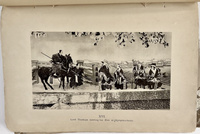
The staging of actors within complex settings that blended obviously theatrical elements with aspects of greater realism ultimately reinforced the capability of reading the visual narrative as both history and performance, an approach fully in keeping with earlier Japanese experiences of woodblock-print visuality. The resulting volume drew on a similar comfort with ambiguity in defining these categories in the Western literary and photographic traditions. Thus, despite the very unfamiliar story, the Western audience could, arguably, appreciate the work in much the same manner as Japanese viewers did when viewing prephotographic woodblock prints of the story. As a coda, the final image in the book speaks to the many layers of truth and fiction embodied in these images and the book as a whole. Lord Tsuchiya Meeting the Rōnin at Riyogoku-bashi (fig. 23) depicts a scene from the tale that incorporates neither living actors nor the photography studio. Rather, it shows a set of papier-mâché iki-ningyō on display in the Tokyo neighborhood of Dangozaka. Iki-ningyō were life-size, very realistic dolls that were a popular form of public entertainment in the late nineteenth century in Japan, often set up as tableaux of popular stories such as Chūshingura.[56] In this setting, the characters depicted as dolls are in fact identified as specific individuals by the text placards near their feet, unlike the living actors posed throughout the book, who lack identification. As Murdoch’s text notes, the key figure is based on one of the most famous Japanese actors, Ichikawa Danjurō. With this concluding reference to yet another complex form of visual culture blending fact and fiction, Ogawa’s Chiushingura continues the complexity of the story and its dual interpretations as it originated in Japan, bringing it to a broader, nineteenth-century English-speaking audience.
Acknowledgments
I would like to thank Isabel Taube, Luke Gartlan, and the anonymous reviewer for their insightful comments, as well as the many colleagues who provided feedback on early versions of this essay. I am grateful to the Faculty Development Fund at the University of San Francisco for providing research support for the project.
Notes
[1] See, for example, Basil Hall Chamberlain and W. B. Mason, A Handbook for Travellers in Japan, 4th rev. ed. (London: John Murray; Yokohama/Shanghai/Hong Kong/Singapore: Kelly & Walsh; Tokyo: K. Ogawa, Hiyoshi-chō, 1894).
[2] Ogawa Kazumasa, with descriptive text by James Murdoch, Scenes from the Chiushingura and the Story of the Forty-Seven Rōnin (Tokyo: K. Ogawa, 1892). Throughout this essay, I use the term Chiushingura to refer to Ogawa’s volume, and the contemporary transliteration Chūshingura for other references to various iterations of the story. Following Japanese custom, Japanese names are listed with the surname first, in the main text and in the notes.
[3] For an overview of Yokohama photography, see Allen Hockley, “Felice Beato’s Japan: Places,” MIT Visualizing Cultures, Massachusetts Institute of Technology, 2008, https://visualizingcultures.mit.edu/; and Alona Wilson, “Felice Beato’s Japan: People,” MIT Visualizing Cultures, Massachusetts Institute of Technology, 2010, https://visualizingcultures.mit.edu/.
[4] Werner Wolf, “Intermediality,” in Routledge Encyclopedia of Narrative Theory, ed. David Herman, Manfred Jahn, and Marie-Laure Ryan (London and New York: Routledge, 2005), 253.
[5] Irina O. Rajewsky, “Intermediality, Intertextuality, and Remediation: A Literary Perspective on Intermediality,” Intermédialités: Histoire et théorie des arts, des lettres et des techniques / Intermedialities: History and Theory of the Arts, Literature and Techniques, no. 6 (Fall 2005): 46. Additional key sources include Gabriele Rippl, ed., Handbook of Intermediality: Literature – Image – Sound – Music (Berlin and Boston: De Gruyter, 2015); Henry Jenkins, Convergence Culture: Where Old and New Media Collide (New York: New York University Press, 2006); Jay David Bolter and Richard A. Grusin, Remediation: Understanding New Media (Cambridge, MA: MIT Press, 1999); and Werner Wolf, “The Concept ‘Transmediality,’ and an Example: Repetition across Arts/Media,” Aletria 32, no. 1 (2022): 213–32.
[6] Of particular note among English language sources is Henry Smith’s comprehensive writing on Chūshingura, which covers the historical events, their literary and theatrical interpretations, and the historiography of the subject. See in particular Henry Smith, “The Capacity of Chūshingura: Three Hundred Years of Chūshingura,” Monumenta Nipponica 59, no. 1 (Spring 2003): 1–42; Henry Smith, “The Media and Politics of Japanese Popular History: The Case of the Akō Gishi,” in Historical Consciousness, Historiography, and Modern Japanese Values, ed. James C. Baxter (Kyoto: International Research Center for Japanese Studies, 2006), 75–97; and Henry Smith, “Chūshingura in the 1980s: Rethinking the Story of the Forty-Seven Rōnin,” in Revenge Drama in European Renaissance and Japanese Theatre: From Hamlet to Madame Butterfly, ed. Kevin J. Wetmore Jr. (New York: Palgrave Macmillan, 2008), 187–215.
[7] Key art historical sources in English include David Bell, Chushingura and the Floating World: The Representation of Kanadehon Chushingura in Ukiyo-e Prints (Richmond, Surrey: Japan Library, 2001); Chelsea Foxwell, “The Double Identity of Chūshingura: Theater and History in Nineteenth-Century Prints,” Impressions, no. 26 (2004): 22–43; Barry Till, “The Vendetta of the Forty-Seven Rōnin in Japanese Woodblock Prints,” Arts of Asia (July–August 2012): 112–23; and Aleksandra Görlich, ed., The Treasury of Loyal Retainers: The Drama of the 47 Rōnin (Krakow, Poland: Manggha Museum of Japanese Art and Technology, 2012). In Japanese, see, among many others, Akō Shiritsu Rekishi Hakubutsukan shūzō, Chūshingura no ukiyo-e [Ukiyo-e of Chūshingura] (Akō City: Akō Shiritsu Rekishi Hakubutsukan, 2004); and Chūshingura: Waseda Daigaku Engeki Hakubutsukan shoz [Chūshingura: Waseda University Theater Museum collection], 2 vols. (Tokyo: Waseda University, 1992–93).
[8] The most substantive English-language research on the relationship between kabuki and photography is an article by Maki Fukuoka, “The Fluidity of Representation: Early Photographs, Asakusa, and Kabuki,” in Portraiture and Early Studio Photography in China and Japan, ed. Luke Gartlan and Roberta Wue (London: Routledge, 2017), 159–73. Research in Japanese is somewhat more developed, but still comparatively sparse; two important recent volumes are Murashima Ayaka, Butai no omokage: Engeki shashin to yakusha shashinshi [Reminiscences of the stage: Theatrical photography and actor photographers] (Tokyo: Shinwasha, 2022); and Kamiyama Akira, ed., Engeki to media no nijiseiki [Twentieth-century theater and media], (Tokyo: Shinwasha, 2020). In contrast to the literature in Japanese studies, there is ample research on the intersection of photography and theater in the English-speaking world, including Joel Anderson, Theatre and Photography (London: Palgrave, 2015); Joel Anderson and Wiebke Leister, “The Theatre of Photography: Dialogues,” Photography and Culture 11, no. 2 (2018): 121–38; Malcolm R. Daniel, “Darkroom vs. Greenroom: Victorian Art Photography and Popular Theatrical Entertainment,” Image 33, no. 1–2 (1990): 13–20; Lori Pauli, ed., Acting the Part: Photography as Theatre (London: Merrell, 2006); Daniel A. Novak, “Caught in the Act: Photography on the Victorian Stage,” Victorian Studies 59, no. 1 (2017): 35–64; and Karel Vanhaesebrouck, “Theatre, Performance Studies and Photography: A History of Permanent Contamination,” Visual Studies 24, no. 2 (2009): 97–106. There is also extensive literature on the relationship of photography and literature in the Anglo-American world, a subject that is also just in its nascent stages in Japanese scholarship. See, for example, Jennifer Green-Lewis, Framing the Victorians: Photography and the Culture of Realism (Ithaca, NY: Cornell University Press, 1996); and Nancy Armstrong, Fiction in the Age of Photography: The Legacy of British Realism (Cambridge, MA: Harvard University Press, 1999).
[9] Foxwell, “Double Identity of Chūshingura,” 24.
[10] Foxwell, “Double Identity of Chūshingura,” 24.
[11] Chelsea Foxwell, “Body, Site, and Memory: Some Observations on Chūshingura in Nishiki-e,” in Görlich, Treasury of Loyal Retainers, 34.
[12] Allen Hockley explores issues related to the perceived authenticity of photography and its relationship with text in his “Packaged Tours: Photo Albums and Their Implications for the Study of Early Japanese Photography,” in Reflecting Truth: Japanese Photography in the Nineteenth Century, ed. Nicole Coolidge Rousmaniere and Mikiko Hirayama (Amsterdam: Hotei Publishing, 2004), 66–85.
[13] Dates are given in the form of the lunar calendar then in use in Japan.
[14] According to Henry Smith, the earliest plays drawing on the Akō incident had appeared by 1710. Smith discusses how the play first became popular in the Kyoto-Osaka area, which, given its distance from the capital of Edo (modern Tokyo), was less susceptible to shogunal censorship. Smith, “Chūshingura in the 1980s,” 191–92.
[15] Note that these points are not unique to Chūshingura, and kabuki plots in general are known for often being somewhat meandering.
[16] James R. Brandon, Chūshingura: Studies in Kabuki and the Puppet Theater (Honolulu: University of Hawaii Press, 1982), vii.
[17] A brief summary appears in M. [Isaac] Titsingh, Illustrations of Japan, trans. Frederic Shoberl (London: R. Ackermann, 1822), 22–23.
[18] These included carbon printing and plate making, heliotypes, and collotype, according to W[illiam]. K. Burton, “A Japanese Photographer,” Anthony’s Photographic Bulletin 21, no. 6 (1890): 184. For an overview of Ogawa’s biography, see Terry Bennett, Photography in Japan, 1853–1912 (Rutland, VT, and Tokyo: Tuttle Publishing, 2006), 210–16. For information on Ogawa’s printing operations at this time, see Sebastian Dobson, “Images from the Front: Japan’s Modern Wars in the Age of Lithography and Photomechanical Reproduction,” in Conflicts of Interest: Art and War in Modern Japan, ed. Philip K. Hu, exh. cat. (Saint Louis: Saint Louis Art Museum; Seattle: University of Washington Press, 2016), 45–46. Despite Ogawa’s prolific output and significant role as a key figure in late nineteenth-century Japanese culture, there is a surprising dearth of English-language scholarship on his oeuvre; the most substantive scholarly reference is Kelly M. McCormick, “Ogawa Kazumasa and the Halftone Photograph: Japanese War Albums at the Turn of the Twentieth Century,” TransAsia Photography 7, no. 2 (Spring 2017), http://hdl.handle.net/. For a recent comprehensive study in Japanese, see Okatsuka Akiko, Teikoku no shashinshi Ogawa Kazumasa [Imperial photographer Ogawa Kazumasa] (Tokyo: Kokusho kankōkai, 2022).
[19] A short article of 1889 on Ogawa’s collotypes notes that “several hundred proofs can be drawn from one plate, and an indefinite number of plates can be made from one negative.” “The Photographic Society of Japan,” Anthony’s Photographic Bulletin 20, no. 22 (1889): 699. For a discussion of Ogawa’s adaptation of halftone printing slightly later, in the mid-1890s, see McCormick, “Ogawa Kazumasa and the Halftone Photograph.”
[20] “The Photographic Society of Japan,” 699.
[21] Burton, “A Japanese Photographer,” 185.
[22] “From the Japan Mail of June 12, 1893: Japanese and Foreign Photographs,” Anthony’s Photographic Bulletin 24, no. 14 (1893): 443.
[23] “No. II of ‘Costumes and Customs,’” Japan Weekly Mail, December 17, 1892, 749; and “Photographic Albums,” Japan Weekly Mail, October 7, 1893, 404–5.
[24] “The Great Earthquake in Japan, 1891,” Anthony’s Photographic Bulletin 23, no. 7 (1892): 218; originally published in Japan Daily Mail, January 18, 1892. Note that the photographs in this volume were taken by William Burton; Ogawa was responsible for the collotype printing and overall book production. A digitized version of “The Great Earthquake in Japan, 1891” can be viewed on the Internet Archive, https://archive.org/.
[25] Ogawa and Murdoch, Scenes from the Chiushingura, n.p.
[26] Okatsuka, Teikoku no shashinshi Ogawa Kazumasa, 218.
[27] Additional examples of similar photographs can be seen in Hockley, “Felice Beato’s Japan: Places”; and Allen Hockley, “Globetrotters’ Japan: Places,” MIT Visualizing Cultures, Massachusetts Institute of Technology, 2010, https://visualizingcultures.mit.edu/.
[28] I do not address here the Japanese text on this sliding door; nor do I attempt to identify the actors or discuss more subtle visual elements that would likely be familiar to Japanese kabuki aficionados, as these are beyond the scope of this paper’s focus on an English-speaking audience. Note also that Ogawa’s images are atypical compared to those that kabuki fans would tend to purchase; kabuki photographs sold to Japanese consumers would generally showcase specific, well-known actors who were readily identifiable, sometimes as portraits of the actors as individuals but other times by representing them in the roles they played in specific productions. These would usually be cartes-de-visite (calling cards) of individuals, rather than the tableaux compositions seen in Ogawa’s images. As an example, see Kabuki Actor Nakamura Kanjaku III as Yuminosuke in ‘Horaisan Soga No Kaomise’ Performed at the Morita-za Theatre, Tokyo, in the First Month of 1871 (Meiji 4), in the collection of the British Museum, London, https://www.britishmuseum.org/.
[29] See a typical example from the 1870s–90s by Japanese photographer Kusakabe Kimbei, in the collection of the J. Paul Getty Museum, Los Angeles, https://www.getty.edu/.
[30] The Library of Congress website gives a date range of 1804–12 for the print series, citing information gathered from specialists on Edo prints from Nichibunken (International Research Center for Japanese Studies in Kyoto). See search results for Katsushika Hokusai’s print series of Chūshingura, Photos, Prints, Drawings, Library of Congress, accessed July 21, 2023, https://www.loc.gov/. The online Hokusai catalogue raisonné specifies a date of 1801 for the set. See “Storehouse of the Loyal Retainers, 1801 Edition,” Katsushika Hokusai: Catalogue Raisonné, accessed July 21, 2023, https://www.hokusai-katsushika.org/. This is also the date specified in the databases for other collections that have copies of these prints, including the Museum of Fine Arts, Boston.
[31] See Hockley, “Packaged Tours,” 81, fig. 15; 82, fig. 16, for additional photographs of hara-kiri. Another photograph appears in R. B. Peery, The Gist of Japan: The Islands, Their People, and Missions (New York: Fleming H. Revell, 1897), 85, https://www.gutenberg.org/. Hockley also speaks to the Western fascination with samurai traditions in Hockley, “Felice Beato’s Japan: Places.”
[32] Bell, Chushingura and the Floating World, 12.
[33] Bell, Chushingura and the Floating World, 19.
[34] Bell, Chushingura and the Floating World, 20 (my emphasis).
[35] Bell, Chushingura and the Floating World, 20–21.
[36] Marie-Laure Ryan, “On the Theoretical Foundations of Transmedial Narratology,” in Narratology beyond Literary Criticism: Mediality, Disciplinarity, ed. Jan Christoph Meister (Berlin and New York: Walter de Gruyter, 2005), 1.
[37] Ogawa and Murdoch, Scenes from the Chiushingura, 1.
[38] Ogawa and Murdoch, Scenes from the Chiushingura, 24.
[39] Ogawa and Murdoch, introduction to Scenes from the Chiushingura, n.p.
[40] Smith, “Chūshingura in the 1980s,” 195. As Smith notes, Shigeno’s revision also marked the “transformation of Chūshingura into what amounted to a piece of propaganda on behalf of martial values and selfless sacrifice to the [modern] state.”
[41] Ogawa and Murdoch, Scenes from the Chiushingura, 13–16.
[42] Ogawa and Murdoch, Scenes from the Chiushingura, 16.
[43] Ogawa and Murdoch, Scenes from the Chiushingura, 21.
[44] Ogawa and Murdoch, Scenes from the Chiushingura, 21–22.
[45] Ogawa and Murdoch, Scenes from the Chiushingura, 22.
[46] Ogawa and Murdoch, Scenes from the Chiushingura, 23.
[47] Ogawa and Murdoch, Scenes from the Chiushingura, 27–28.
[48] Ogawa and Murdoch, Scenes from the Chiushingura, 30.
[49] Ogawa and Murdoch, Scenes from the Chiushingura, 30. My thanks to Nathan Dennis for assistance interpreting this quote.
[50] Neil Harris, “Iconography and Intellectual History: The Half-tone Effect,” in New Directions in American Intellectual History, ed. John Higham and Paul K. Conkin (Baltimore: Johns Hopkins University Press, 1979), 199.
[51] Ralph Bogardus, Pictures and Texts: Henry James, A. L. Coburn, and New Ways of Seeing in Literary Culture (Ann Arbor, MI: UMI Research Press, 1984), 107.
[52] Some, though not all, of the characters look as though they are wearing white makeup, but none of the figures appear in the most dramatic and colorful styles of makeup for which kabuki is well known. For an example of a slightly later photograph of kabuki actors in full makeup, also aimed at a Western audience and published in Francis Brinkley’s Japan: Described and Illustrated by the Japanese (Tokyo and Boston: Millet, 1897–98), see Allen Hockley, “Globetrotters’ Japan: People – Foreigners on the Tourist Circuit in Meiji Japan,” MIT Visualizing Cultures, Massachusetts Institute of Technology, 2010, https://visualizingcultures.mit.edu/.
[53] Marta Weiss, “Staged Photography in the Victorian Album,” in Pauli, Acting the Part, 82.
[54] Carol Armstrong, Scenes in a Library: Reading the Photograph in the Book, 1843–1875 (Cambridge, MA: MIT Press, 1998), 18.
[55] Luke Gartlan, A Career of Japan: Baron Raimund von Stillfried and Early Yokohama Photography (Leiden and Boston: Brill, 2016), 201, 199.
[56] Although iki-ningyō were typically life-size, I have been unable to confirm the scale of those in the photograph. Based on what appears to be the top part of a wall underneath the figures, they look as though they are smaller than life-size. For a fascinating study that considers the novel intersection of iki-ninkyō and photography in Tokyo’s entertainment quarters, see Maki Fukuoka, “Selling Portrait Photographs: Early Photographic Business in Asakusa, Japan,” History of Photography 35, no. 4 (2011): 355–73.